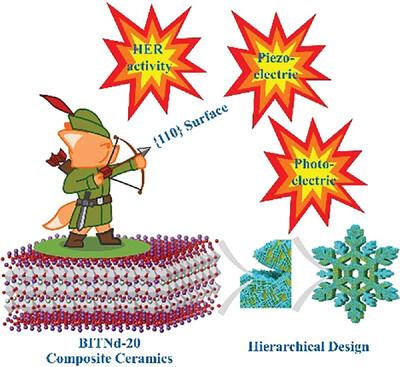{110} Surface-Exposed Bi3.15Nd0.85Ti3O12 Ferroelectric Nanosheet Arrays on Porous Ceramics as Efficient and Recyclable Piezo-Photocatalysts
IF 13
2区 材料科学
Q1 CHEMISTRY, MULTIDISCIPLINARY
引用次数: 0
Abstract
Bismuth-layered ferroelectric nanomaterials exhibit great potential for piezo-photocatalysis. However, a major challenge lies in the difficulty of recovering the catalytic powders, raising concerns regarding secondary pollution of water. In this work, a novel hierarchical porous ferroelectric ceramic containing {110} surface-exposed Bi3.15Nd0.85Ti3O12 (BIT-Nd) nanosheet arrays is grown on a porous ceramic matrix for efficient and recyclable piezo-photocatalysis. By controlling the BIT-Nd loading level of the nanosheets, the piezo-photocatalytic degradation efficiency of a Rhodamine B(RhB) (C0 = 10 mg L−1) solution reached an optimum value of 97.1% in 100 min with a first-order kinetic rate constant, k, of up to 0.0321 min−1 in Bi3.15Nd0.85Ti3O12-20 (BITNd-20) with a mass ratio of hydrothermal products to ceramics of 20%. In the presence of BITNd-20, a surprising H2 yield rate of 130 µmol·h−1 is achieved without using any cocatalyst or scavenger. Specially, the beneficial role of snowflake structures on piezoelectric potential amplification and introducing nanosheets with exposed {110} surfaces on hydrogen evolution reaction (HER) activity, piezoelectric potential output, and catalytic performance of porous ceramics has been revealed. This unique design strategy provides a new approach to enhance the piezo-photocatalytic activity by addressing environmental issues and enhancing catalytic performance to yield cleaner energy.

求助全文
约1分钟内获得全文
求助全文
来源期刊

Small
工程技术-材料科学:综合
CiteScore
17.70
自引率
3.80%
发文量
1830
审稿时长
2.1 months
期刊介绍:
Small serves as an exceptional platform for both experimental and theoretical studies in fundamental and applied interdisciplinary research at the nano- and microscale. The journal offers a compelling mix of peer-reviewed Research Articles, Reviews, Perspectives, and Comments.
With a remarkable 2022 Journal Impact Factor of 13.3 (Journal Citation Reports from Clarivate Analytics, 2023), Small remains among the top multidisciplinary journals, covering a wide range of topics at the interface of materials science, chemistry, physics, engineering, medicine, and biology.
Small's readership includes biochemists, biologists, biomedical scientists, chemists, engineers, information technologists, materials scientists, physicists, and theoreticians alike.
 求助内容:
求助内容: 应助结果提醒方式:
应助结果提醒方式:


